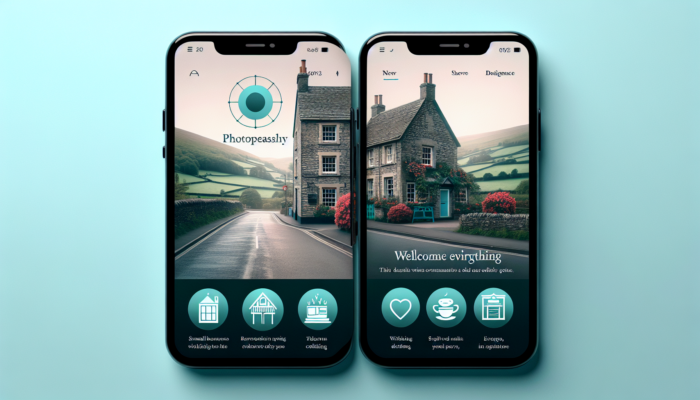Serving Alt Text and surrounding areas for over 25 years.
Trusted by local business for reliable website design, SEO services and Digital Marketing in Somerset, Dorset, Devon, Wiltshire and Gloucestershire. 30 years of online marketing experience across the world.
Table of Contents
ToggleEnhancing Your SEO Strategy with Effective Alt Text Usage
Maximise SEO Benefits through Strategic Alt Text Implementation

Use Local Keywords in Alt Text: The strategic application of local keywords in alt text can significantly boost your website's SEO effectiveness and overall performance. Search engines crucially depend on alt text to decode and interpret the content of images, which can lead to improved visibility in search engine results pages (SERPs). By meticulously optimising images with relevant local keywords, search engines like Google can more accurately index and understand the context of your visual content. As a result, when users search for specific terms associated with your images, they are more likely to discover your website, thus increasing your site traffic. Well-crafted alt text serves as a vital link between your visual assets and the algorithms that determine their discoverability.
In addition, optimised alt text is instrumental in enhancing visibility within image search results. With the growing consumption of visual content online, accurately describing images with targeted local keywords can significantly enhance user engagement rates. This strategy goes beyond merely attracting search traffic; it aims to connect with an audience that finds your visual content relevant to their search needs. Improved visibility consequently leads to increased clicks and, ultimately, higher conversion rates, making well-written alt text an essential component in any digital marketer’s toolkit.
Enhancing User Experience through Thoughtful Alt Text Descriptions
Providing well-crafted alt text is crucial for significantly enhancing the overall user experience, particularly for individuals with visual impairments. Alt text functions as a descriptive tool that provides context for images that may not be visible to all users. When users navigate your website using screen readers, thoughtfully written alt text allows them to grasp the visual content as intended. This commitment to inclusivity not only promotes longer site visits but also lowers bounce rates, as users are more inclined to find relevant content that meets their needs.
When you use local keywords in alt text, you improve accessibility while also ensuring that users searching for location-specific information can easily connect with your content. For instance, a user searching for “local parks in Manchester” will benefit from descriptive alt text that enhances their understanding of an image, resulting in a more engaging and informative experience. Alt text thus serves as a pivotal intersection where effective SEO strategies meet user-centric design, creating a more inclusive digital environment.
Facilitating Search Engine Crawling with Optimised Alt Text
Search engine crawling represents a crucial process that enables search engines to discover and index new content across the web. The inclusion of relevant local keywords in alt text can significantly expedite this process. When search engines crawl your site, they examine various elements, including images. If images lack proper descriptions, they may be overlooked, resulting in missed opportunities for valuable traffic. By incorporating thoughtfully crafted alt text, you provide search engines with a clear roadmap to discern the relevance and context of the surrounding content.
Furthermore, images that are correctly indexed enhance the likelihood of appearing in Google Images search results, potentially driving additional traffic to your site. The synergy between accurately formatted alt text and search engine algorithms can lead to improved rankings, particularly for location-specific queries. Therefore, optimising alt text for images is not merely a recommended best practice; it is a strategic initiative that can profoundly influence how effectively your content is discovered online.
Compliance with Accessibility Standards through Effective Alt Text

Ensuring that your website adheres to accessibility standards is no longer a mere option; it is an absolute necessity. The Web Content Accessibility Guidelines (WCAG) recommend that all visual media, including images, include appropriate alt text descriptions. By integrating local keywords in alt text, you not only meet legal requirements but also reflect a strong commitment to inclusivity and accessibility. This is particularly significant for users who rely on assistive technologies, as they depend on well-structured and descriptive data to navigate digital content effectively.
Moreover, adhering to accessibility standards can positively enhance your brand's reputation, attracting a more diverse audience. Consumers today are increasingly aware of companies' ethical practices and are more likely to engage with brands that prioritise accessibility. By providing informative and relevant alt text, you convey a powerful message that accessibility matters, thereby contributing to a more enriching user experience and fostering a positive brand perception.
Strategically Selecting Effective Local Keywords
Utilising Keyword Research Tools to Identify Local Keywords
The cornerstone of effective SEO lies in comprehensive keyword research, and utilising local keywords is equally important. Several tools, such as Google Keyword Planner, Ahrefs, and SEMrush, can offer valuable insights into which local keywords are driving traffic within your niche market. When selecting keywords, it is vital to examine factors such as search volume, competition levels, and the intent behind user queries. For example, users searching for “best coffee shop in Edinburgh” have a distinct intent compared to those searching merely for “coffee shop.”
When integrating these insights into your alt text, it is crucial to ensure that the keywords align seamlessly with the visual content you are describing. Such alignment not only boosts SEO performance but also enriches the user experience. Users are more likely to engage with images that resonate with their local searches, ultimately resulting in improved interaction and potential conversions for your business.
In addition, consider employing localised variants of keywords to capture a broader audience. Instead of solely using the term “restaurant,” you could refine your search to include specific neighbourhoods or popular local dishes. This level of detail can help your content stand out in a saturated market and effectively drive local traffic to your website.
Gaining Competitive Insights through Keyword Analysis

Analysing competitor keywords represents a strategic approach in the pursuit of effective SEO. By examining the alt text employed by competitors within your niche, you can uncover invaluable insights into which local keywords in alt text are contributing to their success. Tools such as Moz and SpyFu can help you identify the keywords that competitors rank for, giving you insight into their content strategies.
Investigate patterns in their alt text descriptions: Are they utilising long-tail keywords? How are they embedding local elements? By recognising these techniques, you can adapt and refine your approach to gain a competitive advantage. Additionally, this analysis allows you to identify market gaps that you could exploit to attract your target audience more effectively.
However, it is essential to ensure that the keywords you select align with your brand identity and values. Authenticity in your content is critical to establishing trust with your audience. Thus, while competitor analysis is valuable, it should serve as a foundation for innovation rather than a template to replicate.
Striking the Right Balance between Specificity and Relevance
Choosing the appropriate keywords necessitates finding a balance between specificity and relevance. Highly specific local keywords can attract a targeted audience; however, they may also restrict your reach. On the other hand, broad keywords may attract larger traffic yet lack the necessary engagement. The goal is to identify the optimal point where your selected keywords are specific enough to appeal to a niche audience while remaining broad enough to attract additional interest.
For instance, instead of opting for a general keyword like “hotels,” consider a more specific term such as “beachfront hotels in Bali.” This level of specificity provides clarity for search engines and users alike regarding what content to expect. As you use local keywords in alt text, contemplate what your target audience is genuinely searching for and how to reflect that in your descriptions accurately.
Testing various keyword combinations can also yield valuable data regarding performance. Regularly reviewing engagement metrics will help you discern which keywords resonate most effectively with your audience. As trends evolve and user behaviours shift, maintaining adaptability in your keyword strategy is crucial for achieving sustained success.
Effective Implementation of Keywords in Alt Text
Best Practices for Crafting Engaging Alt Text
When implementing local keywords in alt text, adhering to best practices is essential for maximising their effectiveness. Begin by keeping your descriptions concise and focused, ideally within a 125-character range. This length is manageable for screen readers and easily digestible for users. Employing descriptive language is vital: instead of simply stating “dog,” consider expressing it as “golden retriever playing fetch in Central Park.” This approach not only paints a vivid picture for users but also enhances SEO outcomes.
Incorporating your local keywords naturally into the alt text is imperative. This means avoiding forced phrasing that disrupts the flow of your description. For example, if your image showcases a lively market in Melbourne, rather than merely stating “market,” consider elaborating with “vibrant street market in Melbourne bustling with local vendors.” This strategy enhances user engagement while also providing context, making your content more relatable and informative.
Another effective tactic is to focus on the purpose of the image. Why is the image included in your content? What message does it convey? By answering these questions, you can create alt text that aligns with user intent, ensuring your images are more relevant to those searching with specific local keywords.
Avoiding Keyword Stuffing in Alt Text for Better Readability
While it may be tempting to cram multiple local keywords into alt text, keyword stuffing can be counterproductive. This practice not only risks penalties from search engines but also detracts from the user experience. When alt text is overloaded with keywords, it becomes less readable and can cause confusion for users.
Instead, concentrate on writing naturally. Select one or two relevant keywords that accurately reflect the image's content and purpose. This approach guarantees that the alt text flows smoothly while fulfilling its primary objective of enhancing accessibility. Remember, the main function of alt text is to describe the image, rather than to serve as a repository for keywords.
Regularly reviewing and refreshing your alt text can also help maintain high-quality standards. As your keyword strategy evolves, revisit your existing alt text to ensure it remains aligned with current keywords and content themes. By ensuring your alt text is relevant and user-friendly, you can create a positive impact on both SEO and user engagement.
Importance of Regular Updates and Optimisation for Alt Text
The digital landscape is constantly evolving, highlighting the necessity of regular updates and optimisation of your alt text. Trends fluctuate, and user behaviours change over time. Consistently reviewing your alt text ensures that it remains relevant and effective. For instance, if a local event gains popularity, updating your images to reflect this trend can capture the attention of users searching for related content.
Consider incorporating seasonal keywords or timely references into your alt text to enhance its relevance. For example, suppose you operate an aery with a special deal during the holiday season. In that case, revising the alt text of your festive-themed pastries to include local keywords can significantly drive traffic. This not only improves SEO but also aligns your content with current user interests.
Moreover, conducting periodic audits of your alt text can help identify areas needing improvement. Are certain images underperforming? Are they adequately described? By refining your alt text based on performance data, you can construct a more robust SEO strategy that maximises engagement and visibility.
Measuring the Impact of Your Alt Text Strategy
Tracking SEO Performance to Evaluate Alt Text Effectiveness
Measuring the effectiveness of your alt text strategy is essential for understanding its impact on SEO performance. Tools such as Google Analytics and Search Console can provide valuable insights into how well your images rank in search results. Monitoring variations in search rankings over time can help you assess whether your alt text optimisations yield positive results.
When you use local keywords in alt text, track the traffic generated specifically from image searches. This allows you to identify which images drive the most visits and which keywords perform best. The goal is to make data-driven decisions that continually improve your SEO strategy.
Furthermore, consider conducting A/B tests on different alt text descriptions to assess how variations affect click-through rates and user engagement. By comparing the performance of different approaches, you can refine your alt text strategy to align with what resonates most with your audience.
Analysing User Engagement Metrics to Assess Alt Text Performance
User engagement metrics serve as a direct reflection of how effective your alt text is in capturing and retaining audience interest. Tools such as heat maps and user interaction analytics can provide insights into how users engage with your images. Are users clicking on images? How long do they spend on the page? These metrics can help you evaluate whether your alt text is functioning as intended.
When assessing user engagement, pay close attention to bounce rates. A high bounce rate may indicate that users do not find the content relevant or engaging. By refining your alt text to better align with user intent and expectations, you can enhance overall engagement levels, ensuring that users find what they are seeking.
Additionally, consider gathering user feedback on your alt text descriptions. This can be as simple as asking users whether they found the alt text informative and helpful. Incorporating user feedback into your optimisation process can lead to targeted improvements, ultimately resulting in a more satisfying user experience.
Adjusting Alt Text Strategies Based on Performance Data
Data-driven decision-making is at the core of a successful SEO strategy, and your alt text is no exception. Regularly reviewing performance data allows you to discern what is effective and what is less so. If certain keywords or phrases perform exceptionally well, consider emphasising those in your alt text.
Conversely, if specific alt text descriptions underperform, analyse potential contributing factors. Are the keywords too broad or too niche? Is the description lacking detail? By making informed adjustments, you can refine your alt text to meet user needs and preferences better.
Utilising analytics tools to track keyword effectiveness over time can shed light on changing trends. As user behaviour evolves, your alt text strategy should adapt accordingly. Remaining flexible and responsive to data may lead to sustained improvements in visibility and user engagement.
Evaluating Accessibility Compliance of Your Alt Text
Evaluating your alt text's compliance with accessibility standards is crucial for promoting inclusivity and accessibility. Regular audits against guidelines such as the WCAG can help you pinpoint areas where your alt text may be lacking. Ensure that your alt text not only accurately describes images but also provides context for users relying on assistive technologies.
Compliance with accessibility standards can have substantial implications, not only for user experience but also for your brand's reputation. Companies prioritising accessibility often enjoy a competitive advantage in attracting a more diverse clientele, demonstrating their commitment to inclusivity.
Incorporating feedback from users with disabilities can provide insights into how well your alt text meets their needs. Understanding their perspectives can guide improvements and help you achieve a higher level of compliance. Ultimately, an inclusive approach benefits everyone by enhancing user experience and fostering brand loyalty.
Avoiding Common Mistakes in Alt Text Implementation
Avoid Neglecting Alt Text in Your SEO Strategy
One of the most significant errors you can make in your SEO approach is neglecting alt text altogether. Failing to include alt text for images can severely impact both SEO and user accessibility. When alt text is omitted, images are not indexed by search engines, resulting in missed opportunities for traffic and engagement.
Furthermore, users who rely on screen readers will encounter significant barriers when alt text is not provided. This oversight can lead to frustrating experiences, prompting potential customers to leave your site in search of more accessible alternatives. Prioritising alt text in your content strategy is essential for maintaining a user-friendly environment and maximising SEO potential.
Establishing a consistent workflow for adding alt text as part of your content creation process can help ensure that this critical element is never overlooked. By integrating alt text into your routine, you can uphold a high standard for accessibility and SEO across your website.
Steering Clear of Generic Descriptions in Alt Text
Utilising generic descriptions in alt text is another common pitfall. Phrases such as “image of a dog” fail to convey valuable information about the image, thereby limiting its effectiveness for both SEO and user engagement. Generic alt text does not capitalise on the potential of local keywords, resulting in missed opportunities for traffic generation.
Instead, strive for specificity and relevance. An effective alt text description should offer context and insight into the image's content. For instance, rather than simply stating “image of a dog,” consider expanding it to “golden retriever playing fetch in the park.” This approach not only provides more detail but also enhances the likelihood of aligning with user searches.
Regularly reviewing your alt text descriptions can help identify generic phrases and present opportunities for improvement. By refining your descriptions, you can enhance both SEO performance and user experience, ensuring that your content resonates with its intended audience.
Optimising for Mobile Users to Enhance Alt Text Effectiveness
With a significant portion of web traffic originating from mobile devices, neglecting mobile users can adversely affect your SEO strategy. Mobile users often exhibit different behaviours and expectations compared to desktop users, necessitating the optimisation of your alt text for a mobile audience.
As you use local keywords in alt text, consider how users engage with your content on mobile devices. Concise and succinct descriptions tend to resonate better with mobile users, who often seek quick information. Ensure that alt text is formatted for readability on smaller screens, as this can significantly enhance user experience.
Additionally, monitor your site’s performance on mobile devices. Are users engaging with images? Are they spending time on pages that contain optimised alt text? Mobile analytics can provide valuable insights into user engagement, allowing you to refine your strategy accordingly.
Enhancing Accessibility through Effective Alt Text Practices
Ensuring Compatibility of Alt Text with Screen Readers
The compatibility of your alt text with screen readers is vital for enhancing accessibility for all users. Screen readers convert text into speech, enabling visually impaired users to navigate your website effectively. Therefore, crafting alt text that is easily interpretable is of utmost importance.
When composing alt text, prioritise clarity and conciseness. Avoid unnecessary jargon or overly complex phrases. Instead, opt for straightforward language that accurately conveys the image's content. For instance, instead of stating “a dog in a park,” you might say “a happy golden retriever running through a green park.” This not only improves readability but also aids comprehension for users relying on screen readers.
Testing your website with various screen readers can provide valuable insights into how well your alt text performs. By ensuring compatibility, you can enhance the overall user experience for those who depend on assistive technologies to access your content.
Providing Contextual Information to Enrich User Experience
Offering contextual information through alt text is a powerful means to enhance accessibility. When users encounter images on your website, relevant alt text adds depth and understanding, making the content more engaging and accessible. For example, if your website features an image of a community festival, consider describing the atmosphere, activities, and participants in your alt text.
This approach not only benefits users with visual impairments but also elevates the experience for all visitors. For instance, an alt text description that reads “local community festival in Brighton with families enjoying food stalls and live music” provides valuable context, enriching the user's understanding of the image.
Moreover, contextual alt text can further enhance SEO performance, as it provides search engines with a clearer understanding of the content. The more descriptive and relevant your alt text is, the better it can serve both users and search engines alike, enhancing overall visibility.
Addressing Legal and Ethical Considerations in Alt Text Usage
As digital content continues to gain importance, understanding the legal and ethical implications of alt text is crucial. Various regulations, such as the Americans with Disabilities Act (ADA) in the United States and the Equality Act in the UK, mandate that websites must be accessible to all users, including those with disabilities. Failure to comply with these regulations can result in legal consequences.
From an ethical perspective, prioritising accessibility through effective alt text demonstrates a commitment to inclusivity. It signals to your audience that you value diverse user needs and are dedicated to fostering an equitable online environment. This can significantly enhance your brand reputation and cultivate customer loyalty over time.
Furthermore, awareness of these legal and ethical considerations should be integrated into your content creation process. Regularly reviewing your alt text for compliance and accessibility can help ensure that your website aligns with best practices and legal obligations, promoting a more inclusive online experience.
Implementing Best Practices for Alt Text Effectiveness
Implementing best practices for alt text is crucial for maximising its effectiveness across various platforms. Start by ensuring that all images on your website have relevant and descriptive alt text. This consistency not only improves accessibility but also enhances SEO performance and user engagement.
When crafting alt text, keep your audience in mind. What information do they want to glean from the image? Naturally incorporate relevant local keywords. Striking a balance between SEO optimisation and user experience is key to creating impactful alt text.
Regularly revisiting and updating your alt text as part of your content strategy is equally essential. As trends shift and new keywords emerge, adapting your alt text can help you maintain relevance in search results. By adhering to established best practices, you can create a more engaging and accessible online experience for all users.
Integrating Alt Text with Other SEO Elements for Optimal Performance
Creating Synergy Between Alt Text and Meta Tags
Coordinating your alt text with meta tags can lead to a cohesive SEO strategy that enhances your overall site performance. Meta tags provide additional context to search engines about your content, while alt text describes individual images. When both elements are aligned, they can bolster each other’s effectiveness, creating a more robust SEO framework.
For instance, if your image features a local attraction, ensure that your alt text complements the associated meta tags. This alignment not only enhances SEO but also improves user comprehension when they encounter your content in search results.
Moreover, employing similar local keywords across both alt text and meta tags can elevate your chances of ranking for relevant searches. This unified approach can create a stronger impact on search engines, helping to boost your site’s visibility and traffic.
Enhancing Content Relevance Through Alt Text Connection
The relationship between your alt text and surrounding content is critical for creating a seamless user experience. Alt text should complement the content it accompanies, offering additional insights and context that enrich the reader’s understanding.
For example, if your article discusses sustainable tourism practices, ensure that the alt text for images reflects this theme. Describing an image as “an eco-friendly lodge in the Lake District” adds relevance and enhances comprehension for readers. This method not only assists users but also improves SEO by reinforcing topical relevance, making your content more discoverable.
Regularly reviewing the relationship between your alt text and content can help identify opportunities for optimisation. Assess whether your alt text effectively supports the surrounding text, and make necessary adjustments to maintain alignment and coherence throughout your content.
Establishing a Strong Connection Between Alt Text and Keywords
Incorporating relevant keywords into your alt text is essential for improving search engine rankings. When using local keywords in alt text, ensure that they are seamlessly integrated into your descriptions. Forced or awkward phrasing can detract from the user experience and may lead to penalties from search engines for poor optimisation.
A well-crafted alt text description can serve as an additional signal to search engines regarding the relevance of your content. For instance, using a local keyword, such as “historic landmarks in Edinburgh,” in your alt text contributes to a more comprehensive SEO strategy, thereby enhancing your chances of ranking for relevant searches.
Moreover, consider the intent behind the keywords. Understanding the context in which users are searching can help you create alt text that resonates more effectively with them. Regularly revisiting and refining your keyword strategy ensures that your alt text remains relevant and optimised for search engines, driving better results and user engagement.
Frequently Asked Questions (FAQs)
What is alt text?
Alt text, also known as alternative text, is a descriptive written explanation of an image that provides context for screen readers and search engines, thereby aiding in accessibility and enhancing SEO performance.
Why is alt text crucial for SEO?
Alt text helps search engines comprehend the content of an image, thereby increasing visibility in search results and driving more traffic to your website, which is essential for effective SEO.
How do I choose local keywords for my alt text?
Utilise keyword research tools to identify relevant local keywords that align with your content. Consider user intent and search volume when selecting appropriate keywords to ensure optimal engagement.
Can I include multiple keywords in my alt text?
While it is possible, avoid keyword stuffing. Focus on one or two relevant keywords to create more effective alt text that reads naturally and enhances user experience.
How frequently should I update my alt text?
Regular updates are essential, especially as content and trends evolve. Periodically revisit your alt text to ensure it remains relevant, effective, and aligned with your current SEO strategy.
What are the best practices for writing effective alt text?
Keep alt text concise and descriptive, utilise relevant local keywords, and ensure that it complements the surrounding content for maximum SEO impact and enhanced user experience.
Is alt text necessary for all images on my website?
Yes, alt text should be included for all images to improve accessibility and enhance SEO performance, ensuring that all users can effectively engage with your content.
What common mistakes should I avoid with alt text?
Common mistakes include overlooking alt text, utilising generic descriptions, and ignoring mobile optimisation. Ensure your alt text is specific, relevant, and user-friendly to maximise its effectiveness.
How can I measure the effectiveness of my alt text strategy?
Monitor SEO performance, analyse user engagement metrics, and adjust your strategies based on data to assess the effectiveness and impact of your alt text on overall engagement.
What are the key legal considerations I should be aware of regarding alt text?
Adhering to accessibility guidelines such as WCAG is crucial to ensure compliance with legal standards and to promote inclusivity on your website, safeguarding against potential legal repercussions.


















1 Comment
Your insights on the importance of local keywords in alt text are spot on. I’ve seen firsthand how effective alt text can transform the visibility of a website, especially for local businesses. For instance, when optimizing images for a local bakery, using phrases like “fresh croissants in [City Name]” significantly increased both traffic and engagement from the community.